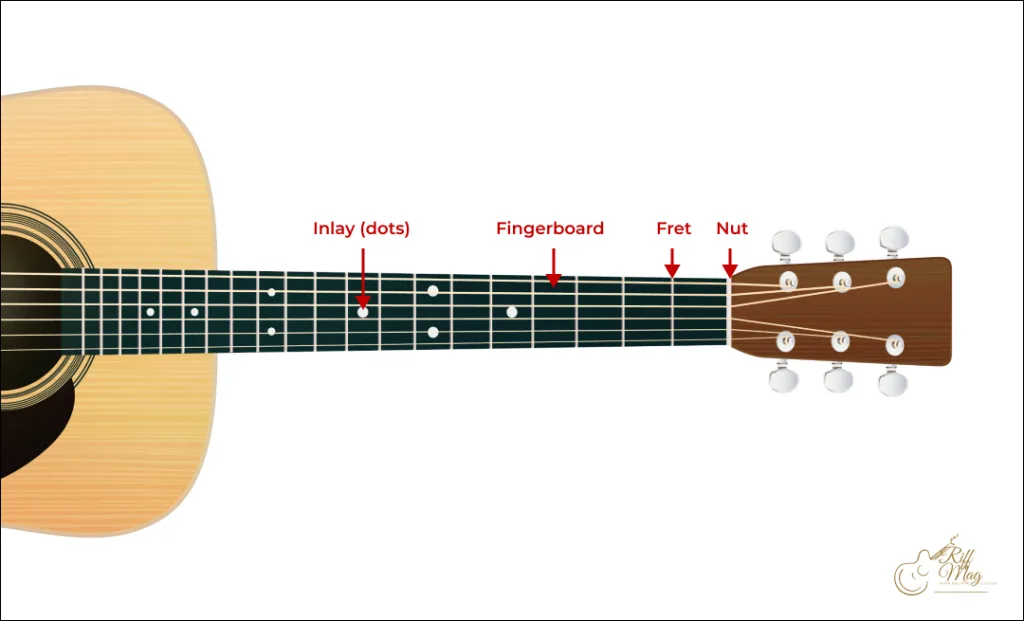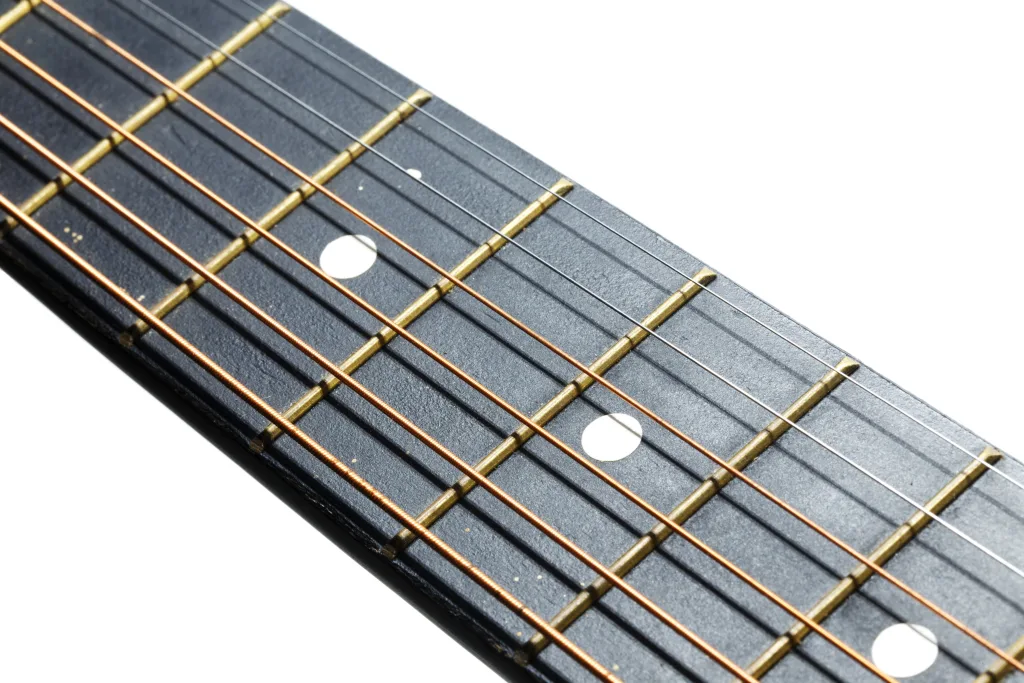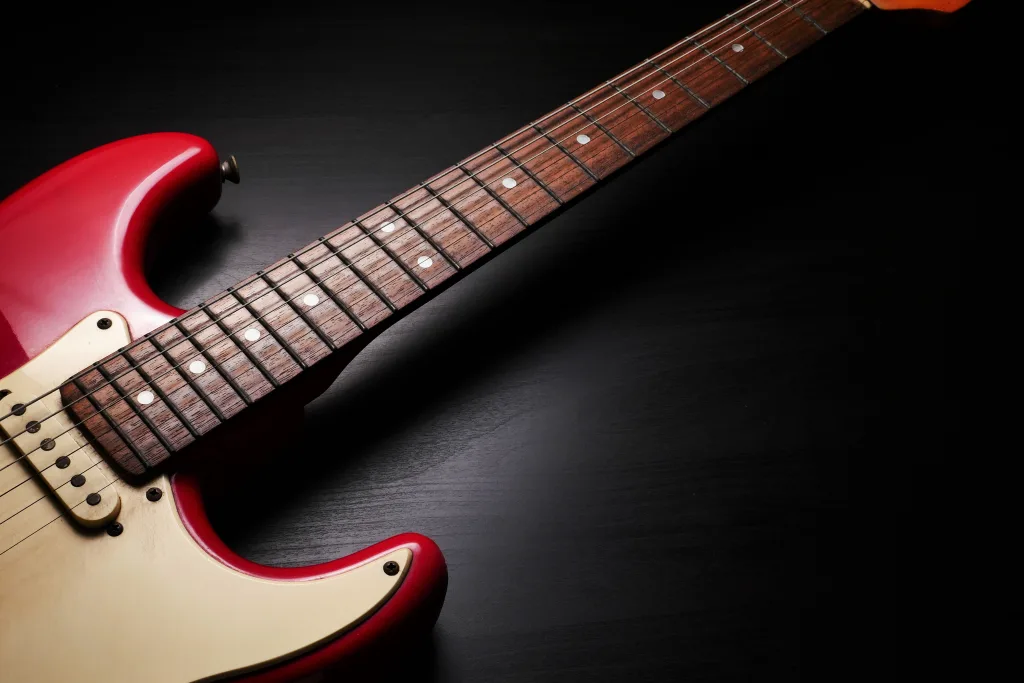Guitars are one of the most popular instruments in the world, and their frets are an important part of what makes them so great.
But what exactly are frets, and how do they work?
In this article, we’ll explain what guitar frets are, how they’re used, and why they’re necessary.
Plus, we’ll provide some tips on fret maintenance to keep your instrument in top shape.
So read on to find out everything you need to know about guitar frets!
What is a Guitar Fret?

A guitar fret is a raised metal element in the fingerboard that divides it into sections, allowing you to play notes with accuracy and precision.
Each section of the guitar’s neck provides enough space for a player to properly fret chords and notes, creating a sound that would otherwise be sharp or flat without frets.
The number and position of these frets are defined by markers along the fingerboard, making them easy to find when getting started on the instrument.
Each guitar has its own scale length, which determines how many frets can fit onto one neck. This allows for plenty of versatility when playing solos or chords.
Thanks to these small metal features, we can easily express our musical ideas with clarity and confidence!
How do Frets Work?
The frets work when you hold down the guitar string on the fretboard, altering the pitch. This process is known as fretting, and it’s an essential part of playing a guitar.
By pressing down strings at certain points along the frets, you can shorten their length and create a desired note or chord. Fretting a string also affects how hard you have to press down on it to get a good sound. If you press too hard, it will be harder to play but if you press too lightly, it won’t sound as clear.
The placement of each fret determines how much shorter the string is made when held down and, therefore what notes can be played with that particular fret location.
For example, pressing lower on the neck increases tension on the strings and creates higher pitched notes while pressing higher up causes less tension and produces lower pitches.
Also, where your fingers are placed between two frets determines how much tension is put onto those strings when they’re plucked – this is called intonation and ensures that all notes played are in tune with each other throughout any given song or piece of music.
Do You Need Frets on a Guitar?
Most of the guitars have frets, but they are not essential.
Fretless guitars offer a wider range of sounds, particularly valued in eastern music.
How to Use Guitar Frets
Using guitar frets can be intimidating for beginners, but with our simple tips, you can quickly master the basics.
Use Your Fingertips
Using your fingertips ensures that every note rings out loud and clear, like a bell in a quiet forest. It’s important to press frets down with your fingertips instead of the pads or your whole finger as this can mute parts of the chords, making them sound bad.
There are several benefits of using your fingertip technique:
- You’ll get better intonation when playing chords and notes;
- You’ll be able to play faster by having more control over each string;
- You will have better accuracy when pressing down on the fretboard.
By using your fingertips, you can ensure that each note is played clearly and accurately.
This tip also helps improve overall dexterity when it comes to playing chords and single notes on the guitar fretboard.
Also, you can use this technique to gain better control over how hard you press against each fret while playing, allowing for more expression in your melodies and chord progressions.
Proper hand posture
Proper hand posture is essential to playing the guitar properly. We found this out after many hours of playing with twisted and injured wrists.
Keeping your wrist in line with your forearm and having a relaxed grip on the neck allows for more freedom of movement across the fretboard.
Keeping an upright posture helps maintain good technique and allows for easier access to higher frets.
It can be difficult at first, but with practice and proper positioning, it’ll soon become second nature.
What are the frets advatages?

Frets have many advantages, and that’s why we make a full list of them. Let’s explore them:
Guitar frets add precision to notes
Guitar frets provide precision to notes, allowing guitarists to make subtle changes in pitch and create unique sounds that simply wouldn’t be possible without them.
For instance, you may use your fretless fingerboard to bend the pitch of a note slightly, creating a hauntingly beautiful effect that gives the song a whole new dimension.
This is especially useful for playing musical styles from different countries or genres which often require very specific notes or intervals that would be difficult to achieve accurately without frets.
Guitar frets add sustain
Guitar frets add sustain that allows the note to ring out much longer than plucking the string would normally allow.
It also helps add precision to notes, allowing you to accurately hit chords or melodies without having to worry about them being too soft or too loud.
The fret acts like an anchor, providing stability and resonance for the string while protecting it from slipping off the board entirely.
With this added protection in place, you can play with confidence, knowing that your notes will be heard no matter how long they are played for.
Sustain gives you more freedom when playing complex songs since you don’t have to worry about losing control over your instrument due to waning string tension.
Additionally, it enhances the overall quality of sound by creating a richer tone that stands out above other instruments in a band setting.
Guitar frets provide better playability
Guitar frets provide better playability, allowing you to glide over the fingerboard more easily and make faster transitions between notes. For me personally, this is the best advantage of all.
Taller frets don’t require as much pressure to make contact with the strings, meaning that they’re great for fast playability and easy bends.
Here are just a few of the benefits of higher frets:
- They help to reduce string buzz and dead notes by providing more contact points.
- You can move around the fingerboard faster without pressing as hard on the strings.
- They help to increase sustain by creating more surface area for string vibration. This makes it easier for you to hold notes longer and creates a bigger sound overall.
Overall, high frets provide an improved playing experience. They allow smoother transitions between notes while also improving sustain and reducing string buzz.
How many frets does a guitar have?
The number of frets can vary a bit depending on the guitar model. Even within the same type of guitar, there can be slight differences in the number of frets.
Sometimes, even guitars of the same model can have different fret counts, and this usually depends on the year they were made.
Guitars with 21 frets
Some guitars have 21 frets for a few reasons, and it’s likely that Leo Fender, the guitar designer, thought about some of them when deciding this. Some people think it was because it was easier to put together, but that’s probably not true.
The position of the neck pickup on a guitar affects its sound, and Fender, who was an engineer, knew this. So, he might have chosen 21 frets to make sure the pickup was in the right place for producing nice lead tones. Fender was also an expert in making guitars, so he probably considered practical things when designing them.
This means that 21 frets might have been chosen because it was easier and cheaper to assemble. So, having 21 frets on a guitar was a good balance between getting good sound and making guitars efficiently.
Guitars with 22 frets
Guitars with 22 frets are now considered the standard. This shift happened to adopt more advanced techniques as players became more experienced.
With this extra fret, guitarists were able to access all 22 frets due to a round body shape that allowed for more accessibility without having to move the neck pickup back towards the bridge and thus affecting its tone.
Popular models of guitars that come with 22 frets include the Gibson Les Paul, Fender Stratocaster, Epiphone Coronet, and ESP LTD EC-256. These guitars have become staples in many genres of music as they offer an extended range of notes for players to explore and express their creativity.
Differences between 22 and 24 fret guitars
The main difference between 22 and 24-fret guitars lies in the pickup location.
On a 22 fret guitar, the neck pickup is placed as close to the neck as possible in order to capture its warm tone. However, this same position on a 24 fret guitar would be too far away from the center of vibration, resulting in a brighter sound.
The longer neck of a 24 fret guitar also makes it necessary to move the neck pickup closer to the bridge than it would be on a 22 fret model. This shift has an effect on tone that some players may prefer, while others may not appreciate it as much as they would have with the warmer sound of their 22 fret guitar.
Ultimately, it’s all about personal preference when it comes to choosing between these two models.
Electric guitar fret numbers

Electric guitar fret numbers can drastically alter the instrument’s sound, making it warm and inviting or bright and biting. Generally speaking, an electric guitar will have between 21 and 24 frets.
Most Fender and Gibson guitars feature 22 frets, however certain models of Stratocasters come with 21.
While some guitars feature 24 frets, such as Ibanez RG550s or Washburn EC36s, there are a few higher fret numbers out there – Ibanez RG550XH has 30 frets while the Jackson Dinky comes with 24.
The extra frets allow for more versatility when playing lead solos but require more practice to master due to their increased length.
The choice between 22 and 24 fret guitars depends on personal preference as both provide unique benefits and drawbacks depending on the style of music one is looking to create.
Acoustic guitar fret numbers

Acoustic guitars typically have 18 to 20 frets, while classical acoustics and flamenco guitars usually come with 19.
However, some acoustic guitars are referred to as 12 or 14 fret guitars due to the point where the neck meets the body at that particular fret.
The range of frets on these various types of acoustic guitars is quite wide, offering musicians plenty of options when it comes to playing styles.
For example:
- the Taylor 312ce-N Grand Concert has 17 frets
- the Gretsch G9500 Jim Dandy Parlor has 18
- the Yamaha CG142 Classical has 19,
- and both the Martin D-35 and Little Martin LX1E have 20 frets.
As you can see, there’s something for everyone when it comes to acoustic guitar frets.
Why do acoustic guitars have fewer frets than electric guitars?
Acoustic guitars have fewer frets than electric guitars because reaching and playing those higher frets on bigger acoustic guitars can be quite a challenge.
It also affects the sound produced as shorter strings vibrate less when played on the upper frets. This makes the sound much less resonant due to the lack of vibration.
Moreover, many styles of music that are played on an electric guitar require those higher frets such as in guitar solos which often go past the 12th fret and sometimes even up to 20th fret or more.
Acoustic guitars, however, are better suited for chords and fingerpicking which don’t usually move past the 12th fret. Therefore, having more frets beyond this point would not be beneficial for acoustic guitar players.
Does it matter how many frets a guitar has?
It matters how many frets your guitar has; the number of frets can drastically affect your sound and playability.
22-fret guitars, for example, tend to have a thicker and warmer tone because they have a shorter neck, with the two pickups – bridge and neck – further apart. This allows for greater access to higher notes and the warm tones of the neck pickup nearer to the nut of the guitar.
Meanwhile, 24 fret guitars are preferred if you’re looking for metal sounds as this genre is more likely to need those higher frets than other genres like country music. 24 fret guitars also offer better access to those higher frets due to their design.
Ultimately, it’s important to consider what type of sound you’re looking for when deciding on how many frets you want in your guitar.
Guitar fret maintenance
Maintaining your guitar frets is vital for keeping your sound crisp and clear. To ensure that your frets remain in excellent condition and you stay comfortable while playing, here are 3 steps that should be taken:
- Inspect them when changing strings to identify any damage or wear.
- Consider switching to stainless steel frets if you press hard as they last longer and provide more comfort.
- Test on the guitar equipped with stainless steel frets before making the switch, as some players have found that they produce a different sound than nickel silver frets.
These steps will help keep your frets in good shape so you can continue jamming out without worrying about intonation issues or developing buzzes from worn-down frets.
Conclusion
You’ve now learned about guitar frets and the advantages they can bring to your playing. Frets are a great way to help you navigate the fretboard with accuracy and precision, allowing you to hit those notes right on the nose.
Knowing how many frets your guitar has and how to properly maintain them is key for maximizing their effectiveness. With all that said, having an understanding of the basics will take you far in mastering this skill – it’s just a matter of putting in the time and effort!
So don’t be shy – step up to the plate and give it a shot; after all, practice makes perfect.
FAQ
How do I know which fret to use for a particular chord?
You can determine which fret to use for a particular chord by looking at the specific notes needed for the chord. It is important to understand how notes are placed on the fretboard in order to identify what fret number will be used.
I often use resources such as online diagrams or music theory books to become familiar with note placement on the guitar frets. You should try it too.
What kind of materials are used to make frets?
Usually, the materials used to make frets are nickel-silver and stainless steel. They are most popular for their durability and playability. Each material has its own unique properties that contribute to sound production.
How do I know if my frets need to be replaced?
Your frets may need to be replaced if the strings sound dull or buzzing when played. Check for any wear on the fretboard or unevenness in the frets and listen for any warping of tones as you play. If needed, take it to a pro for an inspection and replacement.

